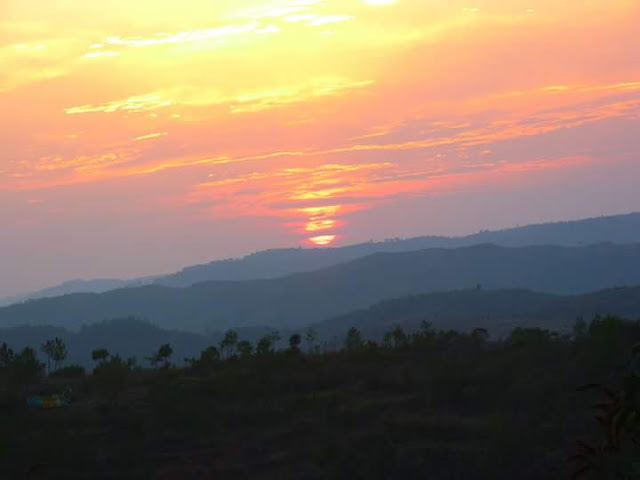By Aritra Majumdar
Travelling
to the North-east was always on the card. So it was with great enthusiasm that
we landed at the Guwahati Airport on a bright April morning for our trip to
Meghalaya.
After
spending the first night at Kaziranga we started for Meghalaya. The road from
Kaziranga to Shillong was an idealistic road-trip - good road, perfect sunshine,
roadside dhabas and some or the other
mountain forming a perfect backdrop. The hairpin bends of the Shillong roads
welcomed us to Meghalaya – the abode of clouds! The meandering roads, the small
villages, the little kids along the highway and the small chapels in between
the villages set the perfect tone for the coming days.
That
day we reached Bara-Pani and what a beauty it was! Known as Lake Umiam (which is
a man-made reservoir), nestled amidst the mountains, 15 Kms from Shillong , it serves
as the biggest source of water for the mountain-dwellers. The water was as
clear as crystal, and the last rays of the sun reflecting on the water turned
it to liquid Gold. We spent the night in a hotel in a small village near the
lake with a panaromic view of the lake and the surrounding trees. The next
morning we woke up early to enjoy a stroll on the banks of the lake. The
experience is inexplicable – incredible view, chirping birds, wayward winds
swaying the bigger trees and the showering the lake with flowers! We also
noticed that the people/government is extremely dedicated to cleanliness-small
boats cleaning the lake to maintain its beauty.
Same
day we travelled to Shillong and it was everything I imagined it to be and
more! Its people-food-love formula and its cultural mix of colonial past and
simple folk culture of the hills of Garo -Khasi- Jaintia is enchanting. Earlier
readings of Rabindranath Tagore’s “Shesher
Kobita” had helped me to visualise the romantic aspects of the mountains,
its warmth, its soft sunshine, the colourful not-so-known flowers along the
paths and simplicity of the mountain folks. And the place certainly didn’t
disappoint. However, the Police Bazaar, the heart of Shillong the market place,
was extremely overcrowded, and unfortunately most hotels are near to it. It takes
away the peace, quiet and beauty of the place. Fortunately we moved to a hotel
near Hyderi Park and the calm and quietness of the mountains were restored.
Next
day we hopped from the Hyderi Park to the Butterfly Museum (Museum of Entomology)
and drove 65 Kms to Mawsynram – reportedly the wettest place on earth. This
place also has a cave where travellers can see stalactites. The drive through
the Khasi Hills was again beautiful and was worth in millions of hot momos!
Another
day and another breathtakingly picturesque road later we reached Cherrapunji. The journey to Cherapunji was by far the most
enjoyable – cliffs, wild flowers, small villages and chapels led the way. Here,
the trek to the Living Root Bridge at Cherrapunji was worth the tiredness and
effort. The view of the meandering river under the root bridge shaded by a dense
canopy of huge trees was exquisite. After a lunch break at a quiet Garo village
called Mawlynnong (Asia’s cleanest village) we experienced the first spell of
shower! A few scattered viewing point such as the seven sister falls, etc took up
the rest of the day and we retired at the Cherrapunji Resort - run by the local
women, a stay at this resort is highly advisable. It was a warm, homely and
comfortable stay.
Local
sightseeing took up the next day. The Nohkhalikai Falls – India’s tallest
plunge waterfall (1115 Feet), Ka Khoh Ramhah, and the double decker living root
bridge are some of the places. Every nature lover should do nothing and just
roam around Cherapunji enjoying the serenity in the lap of the nature.
The
next day was scheduled for Dwaki - India’s international border with Bangladesh,
96 Kms from Shillong. Here, there is a small village market where the two
countries meet (under the Border Security Force survelliance) and lastly the
River! Called the Umngot, it is the natural boundary between Jaintia Hills and
Khasi Hills and the water is so clear that it looks like the boats are flying
in the air instead of floating on water! The local fish, Chittol here is
delicious and this place affords a view of a vast expanse of Banglasdesh –
which was a very personal experience for me, given my ancestral roots lie on
that side of the border.
From
there, it was back to Guwahati for us via Shillong Peak – from where entire
Shillong can be observed, and the Don Bosco Museum with its extensive study on
the people of north eastern states, their food, language, tribes, music and
works of arts.
The
magnificent mountains, hectic roadtrips, picturesque views, lazy afternoons and
quiet Sunday mass is what will always remain with me from this trip. The
breath-taking Meghalaya and its surrounding states indeed reflect diversity of
an Incredible India.
About
Aritra:
This
guy is a true blue Bong, passionate about literature, art, food, music,
photography and what not. An avid traveller from a young age, if he is not busy travelling, he
is definitely busy meticulously planning a trip months ahead – he swears that
is how he manages to disappear about half a dozen times each year in spite of
his tremendous work load.






















0 comments:
Post a Comment